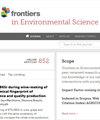通过生物炭与聚丙烯酰胺的结合改善豌豆植物的生长,以应对温室中污水应用下的重金属胁迫
IF 3.3
3区 环境科学与生态学
Q2 ENVIRONMENTAL SCIENCES
引用次数: 0
摘要
污水被广泛用于灌溉,是植物生长的宝贵资源,可提高农业生产率。然而,这种做法也会导致重金属在土壤中大量积累,对环境和健康造成潜在风险。我们设计了一项研究,以评估添加剂对固定土壤中的重金属以及改善豌豆植物生长和产量的综合影响。为此,将每种处理的土壤与生物炭(BC)(1% w/w)、聚丙烯酰胺(PAM)(0.5% w/w)混合,并同时施用。用自来水 (TW)、污水 (SW) 和自来水 + 污水 (TW + SW) 灌溉豌豆植株。采用因子设计对数据进行统计分析。生物炭和聚合物的联合应用产生了积极的效果,显著提高了植物生长参数(39%-84%)、生理属性(67%-69%),并降低了施用 SW 和 TW + SW 的土壤中的镉浓度(56%)和铬浓度(65%)。此外,联合施用 BC 和 PAM 可显著降低根中镉浓度 43%、芽中镉浓度 50%、谷物中镉浓度 91%。同样,与对照组相比,根中的铬浓度降低了 51%,芽中的铬浓度降低了 51%,谷物中的铬浓度降低了 94%。总之,研究结果表明,与潜在有毒元素(PTEs)相关的生物累积和健康风险降低,支持将聚合物和生物炭用于 TW + SW 灌溉豌豆植物。利用聚合物和生物炭添加剂的综合优势,似乎是修复受 PTE 污染的土壤,从而提高植物生长和产量的有效策略。本文章由计算机程序翻译,如有差异,请以英文原文为准。
Improving the growth of pea plant by biochar–polyacrylamide association to cope with heavy metal stress under sewage water application in a greenhouse
Sewage water is extensively used for irrigation, serving as a valuable resource for plant growth to enhance agricultural productivity. However, this practice also results in a significant accumulation of heavy metals in the soil, posing potential environmental and health risks. A study was designed to evaluate the combined effect of amendments on heavy metal immobilization in soil and improved growth and yield in pea plants. For this, the soil for each treatment was mixed with biochar (BC) (1% w/w ), polyacrylamide (PAM) (0.5% w/w ), and also applied in combination. Pea plants were irrigated with tap water (TW), sewage water (SW), and tap + sewage water (TW + SW). A factorial design was applied to analyze data statistically. The combined application of the biochar and polymer showed a positive response by significantly enhancing the plant growth parameters (39%–84%), physiological attributes (67%–69%), and reducing Cd (56%) and Cr (65%) concentration in soil applied with SW and TW + SW. Moreover, treatment with a combined application of BC and PAM significantly reduced Cd concentrations by 43% in roots, 50% in shoots, and 91% in grains. Similarly, Cr concentrations were reduced by 51% in roots, 51% in shoots, and 94% in grains compared to the control. Overall, the study results indicate reduced bioaccumulation and health risks associated with potentially toxic elements (PTEs), supporting the application of the polymer and biochar for irrigating pea plants with TW + SW. Leveraging the combined benefits of polymer and biochar amendments appears to be an effective strategy to remediate PTE-contaminated soil, thereby increasing plant growth and yield.
求助全文
通过发布文献求助,成功后即可免费获取论文全文。
去求助
来源期刊

Frontiers in Environmental Science
Environmental Science-General Environmental Science
CiteScore
4.50
自引率
8.70%
发文量
2276
审稿时长
12 weeks
期刊介绍:
Our natural world is experiencing a state of rapid change unprecedented in the presence of humans. The changes affect virtually all physical, chemical and biological systems on Earth. The interaction of these systems leads to tipping points, feedbacks and amplification of effects. In virtually all cases, the causes of environmental change can be traced to human activity through either direct interventions as a consequence of pollution, or through global warming from greenhouse case emissions. Well-formulated and internationally-relevant policies to mitigate the change, or adapt to the consequences, that will ensure our ability to thrive in the coming decades are badly needed. Without proper understanding of the processes involved, and deep understanding of the likely impacts of bad decisions or inaction, the security of food, water and energy is a risk. Left unchecked shortages of these basic commodities will lead to migration, global geopolitical tension and conflict. This represents the major challenge of our time. We are the first generation to appreciate the problem and we will be judged in future by our ability to determine and take the action necessary. Appropriate knowledge of the condition of our natural world, appreciation of the changes occurring, and predictions of how the future will develop are requisite to the definition and implementation of solutions.
Frontiers in Environmental Science publishes research at the cutting edge of knowledge of our natural world and its various intersections with society. It bridges between the identification and measurement of change, comprehension of the processes responsible, and the measures needed to reduce their impact. Its aim is to assist the formulation of policies, by offering sound scientific evidence on environmental science, that will lead to a more inhabitable and sustainable world for the generations to come.
 求助内容:
求助内容: 应助结果提醒方式:
应助结果提醒方式:


